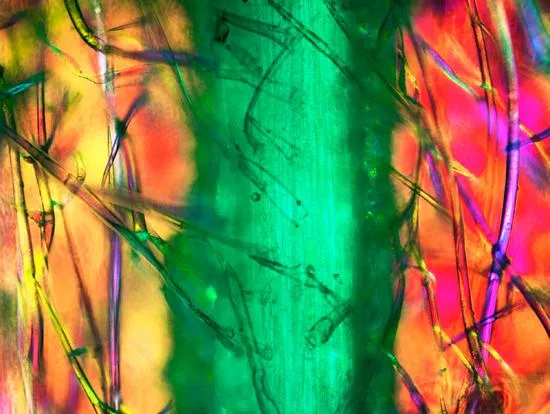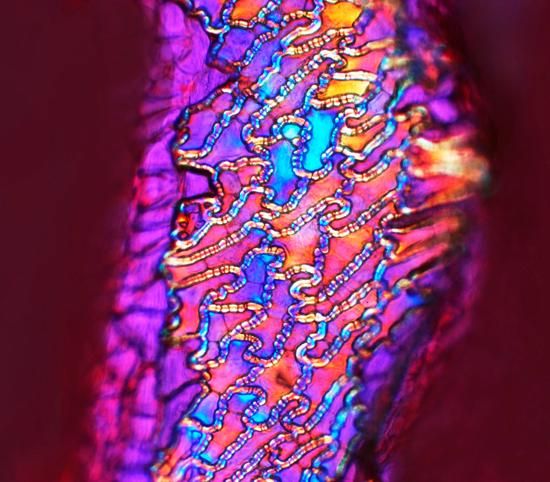Fruits and Vegetables Like You’ve Never Seen Them Before
Microscopy artist Robert Rock Belliveau says, “I couldn’t believe the things I found on the things we eat every day”
/https://tf-cmsv2-smithsonianmag-media.s3.amazonaws.com/filer/15/7d/157d456d-dfaa-494d-aa75-563b59de40b1/20120222110030blueberryt.jpg)
Robert Rock Belliveau worked for years as a pathologist. He examined human tissues and tumors and he says he never tired of the job. “I would go to work and spend ten hours a day looking through a microscope. A couple of times a week, I would say to myself, ‘I can’t believe they pay me to do this.’ I just loved going to work and doing what I did.”
Belliveau continues to examine the world with his polarizing microscope. He’s turned his lens on paper, wildflowers and whatever he can get his hands on. Most often, he focuses on the incredible jungle found in fruits and vegetables. He has more than 2,000 images; two of which—cucumber and tomato trichomes—were recently featured in Science magazine. I talked with him from his home in Nevada.
How did you arrive at such a great enthusiasm for the microscopic world of food?
When I retired, I took a course in botany and I started looking at wildflowers. We had a couple years of drought—I’m out in Las Vegas—so I started looking for a more reliable source, which was going to the grocery store. I couldn’t believe the things I found on the things we eat every day. It’s like another planet. What intrigued me most is that these are things that we put in our mouth and chew up and swallow. We do it every day.
Do you go to the store specifically to shop for specimens?
Well, at first, I said, “As long as I’m shopping for groceries, let’s see what I can see.” Then, I started seeing these amazing things, so sometimes I would go to the grocery store just to find things to look at under the microscope. We have a Vietnamese and a Chinese market, so I began looking at exotic fruits and vegetables. Same thing there. I do it seven days a week. It’s not difficult for me to do. It’s a labor of love and I’m learning a lot about fruits and vegetables that I never knew about. I love talking about it. I talk to my wife about it. I talk to my friends about it. I’d stop people on the sidewalk to talk to them about it.

Tell me about your process. Once you’ve dissected a fruit or a vegetable, how do you go about searching for its compelling parts?
In the beginning, I didn’t know what I was doing. I said, “Let’s take a look just to see what’s there.” Every once in a while, I’d say, “Wow! I can’t believe it.” I began to learn that certain things—the pulp of an apple, the pulp of a pear, or the pulp of a peach—are, by and large, not that interesting. Occasionally, though, you’ll find something interesting, like the pulp of a kiwi. Last week, I was looking the skin of an avocado. I said, “Maybe it’s a waste of time to look at.” But it blew my socks off. After a while, you have a database of what you expect might see. Every once in a while, though, you just can’t believe what you see. It’s like Willie Sutton: You go where you think it’s going to be.
Are there particular hotspots?
The skin of a fruit or a vegetable. The endocarps. The seeds and the seed coat. Sometimes the mesocarp is bizarre. The leaves are sometimes astounding, particularly the under-surface of the leaf, which is a gold mine.
Has examining fruits and vegetables changed your eating habits? Is there anything that makes you not want to eat something now?
There are people in the Philippines, who eat certain fruits. The construction of their pulp has long fibers. If they eat too many of those, they get a bezoar, a coagulation of food, like a hairball in your stomach. They have to have surgery to remove them. There are two or three different fruits that do that same thing. If you want to eat those fruits, you should only eat one or two. We have cactus pads, like prickly pears, and those fruits have a lot calcium oxalate in the skin, which wear down your teeth; it destroys enamel when you chew on them. But the one thing I have sworn off is the skin of cucumbers. I lived in Japan for three years and they never eat the skin of a cucumber because of what they perceive as bitterness. What I can tell you, this has been a real education from me.
